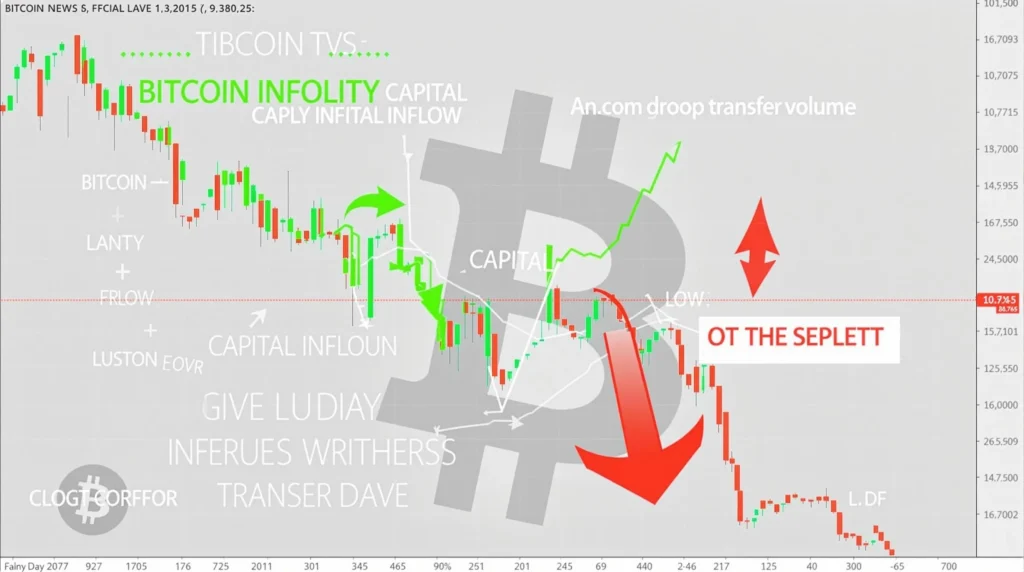Shocking Bitcoin Plunge: Daily Transfer Volume Drops 76% But $160B Capital Surge Sparks Bullish Hope

Bitcoin, the king of cryptocurrencies, is currently navigating a fascinating paradox. Recent data reveals a dramatic 76% drop in daily transfer volume, a figure that might initially raise eyebrows and spark concerns. However, digging deeper into the numbers unveils a compelling counter-narrative: a massive $160 billion net capital inflow into Bitcoin. This significant capital surge, even amidst price fluctuations below the coveted $95,000 mark, has analysts buzzing with bullish sentiment. So, what does this seemingly contradictory data actually mean for Bitcoin and the broader crypto market? Is this dip in transfer volume a cause for alarm, or is it a deceptive signal masking a powerful accumulation phase? Let’s dive into the details and explore what this intriguing development could signify for your crypto portfolio.
Decoding the Bitcoin Transfer Volume Drop: Is it a Red Flag?
A 76% decrease in Bitcoin’s daily transfer volume is undeniably a substantial drop. At first glance, it might appear alarming, suggesting reduced network activity and potentially waning interest in Bitcoin. However, it’s crucial to understand what ‘transfer volume’ truly represents. Transfer volume primarily reflects the total value of Bitcoin moved on-chain within a given day. A decrease could be attributed to several factors, not all of them negative. Let’s consider a few possibilities:
- Reduced Speculative Trading: A drop in transfer volume might indicate a cooling off in short-term speculative trading. If fewer traders are rapidly buying and selling Bitcoin, the on-chain volume naturally decreases. This could actually be a healthy sign, suggesting a shift towards longer-term holding strategies.
- Increased Off-Exchange Activity: A portion of Bitcoin trading and transactions occurs off-exchange, in private wallets or through layer-2 solutions like the Lightning Network. Increased activity in these off-chain environments wouldn’t be reflected in the daily transfer volume figures.
- Market Consolidation: During periods of market consolidation or uncertainty, traders might become more cautious and reduce their on-chain transactions, waiting for clearer market signals.
Therefore, while a 76% drop in transfer volume is noteworthy, it’s essential to analyze it in conjunction with other market indicators, particularly the capital inflow.
The Bullish Signal: $160 Billion Capital Rise Fuels Market Optimism
Now, let’s turn our attention to the truly compelling aspect of this data: the $160 billion net capital rise. This figure is calculated by analyzing Bitcoin’s realized market capitalization. Realized market cap differs from the traditional market cap. Instead of multiplying the current price by the total circulating supply, realized market cap values each Bitcoin at the price it was last moved on-chain. An increase in realized market cap suggests that new capital is flowing into Bitcoin at higher prices than previous levels, indicating strong investor confidence and accumulation.
A $160 billion surge in realized market cap is a powerful indicator of bullish momentum. It suggests that despite the price remaining under pressure below $95,000 and the drop in transfer volume, significant capital is entering the Bitcoin ecosystem. This inflow could be driven by various factors:
- Institutional Investment: Large institutional investors, with their substantial capital reserves, often view price dips as buying opportunities. A $160 billion inflow could signify increased institutional accumulation of Bitcoin.
- Long-Term Accumulation: Long-term Bitcoin holders, often referred to as ‘hodlers’, tend to accumulate Bitcoin regardless of short-term price fluctuations. This capital rise could reflect continued accumulation by these steadfast investors.
- Growing Adoption: Despite market volatility, the fundamental adoption of Bitcoin continues to grow globally. Businesses, individuals, and even nations are increasingly recognizing Bitcoin’s potential as a store of value and a hedge against inflation. This expanding adoption fuels long-term capital inflows.
Bitcoin Market Cap: Realized vs. Traditional – Why it Matters?
Understanding the difference between realized and traditional market capitalization is crucial for interpreting Bitcoin market dynamics. Here’s a table summarizing the key differences:
| Metric | Traditional Market Cap | Realized Market Cap |
|---|---|---|
| Calculation | Current Price x Circulating Supply | Sum of the value of each Bitcoin at the price it was last moved on-chain |
| Focus | Current market valuation based on price | Capital inflow and value accumulation over time |
| Signal | Reflects immediate market sentiment and price movements | Indicates long-term investor conviction and capital accumulation |
| Use Case | Quick overview of market size and ranking | Deeper insights into capital flows and investor behavior |
As you can see, while traditional market cap provides a snapshot of Bitcoin’s current valuation, realized market cap offers a more nuanced perspective on the actual capital invested and held within the Bitcoin network. The $860 billion realized market cap highlighted in the original content strongly suggests that despite price weakness, substantial fresh capital has indeed entered the Bitcoin ecosystem.
Actionable Insights: Navigating Bitcoin’s Current Market Phase
So, what are the actionable takeaways from this analysis? Here are a few points to consider as you navigate the current Bitcoin market:
- Don’t solely focus on transfer volume: While a significant drop in transfer volume should not be ignored, it shouldn’t be the sole indicator for your investment decisions. Consider it within the broader context of market dynamics.
- Pay attention to realized market cap: The realized market cap and its changes can provide valuable insights into capital flows and long-term investor sentiment. A rising realized market cap, like the current $160 billion surge, is a positive signal.
- Look for buying opportunities: The combination of a price dip below $95,000 and a substantial capital inflow might present a potential buying opportunity for long-term investors. However, always conduct thorough research and manage your risk appropriately.
- Stay informed and diversify: The cryptocurrency market is dynamic and volatile. Stay updated on market trends, news, and analysis. Diversification across different cryptocurrencies and asset classes can help mitigate risk.
Conclusion: Bitcoin’s Resilient Bullish Narrative
The current Bitcoin market scenario, characterized by a sharp drop in daily transfer volume alongside a massive $160 billion capital inflow, paints a complex yet ultimately bullish picture. While the decrease in transfer volume might raise initial concerns, the significant capital surge, reflected in the rising realized market cap, suggests strong underlying investor confidence and continued accumulation. This paradox highlights the importance of looking beyond surface-level metrics and delving deeper into the nuances of on-chain data. For astute investors, this period of apparent contradiction might just be a signal of underlying strength and a potential window of opportunity in the ever-evolving world of Bitcoin and cryptocurrency. The resilient nature of Bitcoin, evidenced by this capital inflow despite price fluctuations, reinforces its narrative as a compelling long-term investment in the digital age.









